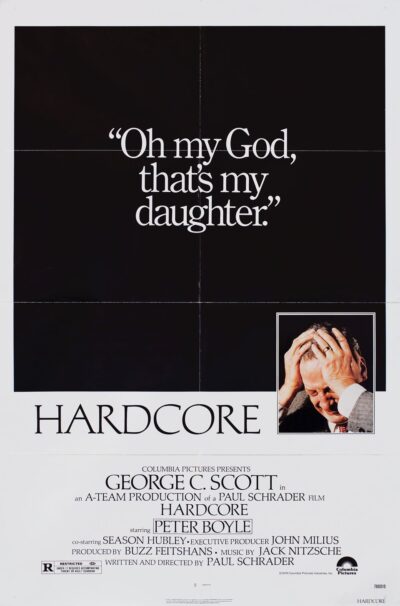In which mainstream Hollywood trained its wide-eyed gaze on the porn industry, with results that (as in BODY DOUBLE and BOOGIE NIGHTS) are interesting, if extremely myopic. HARDCORE (1979), written and directed by Paul Schrader and starring George C. Scott, had the benefit of having been lensed during the golden age of porn, and with a degree of explicitness that pushes the R rating about as far as it can go. For those and other reasons the film, despite not being the best Hollyweird depiction of late 1970s urban sleaze (that honor goes to NIGHT OF THE JUGGLER), is worthwhile. It’s even proven somewhat influential: see French-Canadian MY DAUGHTER, MY ANGEL/Ma fille, mon ange (2007), which bears HARDCORE’s unmistakable influence.
HARDCORE (1979) Trailer
HARDCORE was Schrader’s second directorial effort. Executive produced by his pal John Milius, the film was a hodgepodge, hampered by Scott’s alcoholism and interference by Columbia’s executives, who forced Schrader to accept a lead actress (Season Hubley) he didn’t want (MOMMIE DEAREST’s Diana Scarwid was his preferred choice) and insert an ending quite different from that of his script.
As in Schrader’s iconic screenplay for TAXI DRIVER (1976), HARDCORE offered up a warped twist on THE SEARCHERS (1956), with John Wayne’s racist loner protagonist replaced with Scott as Jake VanDorn, a pious furniture magnate living in Schrader’s hometown of Grand Rapids, MI. All would appear to be harmonious in Jake’s world until his teen daughter Kristen (Ilah Davis) heads to Los Angeles on a Church trip, from which she disappears.
HARDCORE’s first act is quite problematic. Showcased is Schrader’s shaky grasp of normalcy, with a depiction of Jake’s existence in Grand Rapids that never compels (although there is one great line: “I’m sick of watching this television stuff…You know who makes it? All the kids who couldn’t get along here. They go off to California and make television”). The storytelling is downright clumsy, with a scene that forsakes Jake’s point of view to focus on Kristen in LA, chatting with her friends and, it’s implied, gearing up for trouble—we don’t see her again until the final scenes.
Jake flies to LA and hires Andy Mast (Peter Boyle), a sleazy private eye, to track down Kristen. Jake then flies back to Grand Rapids, where a week a later Andy gets in touch with the bad news: Kristen has turned up as a performer in an 8mm porn loop. The shocked Jake watches this loop in a local theater and, in the film’s most famous scene, breaks down and shouts “Turn it off!” (for the record, he never actually says “Oh my god, that’s my daughter”). He then flies back to LA (lots of plane landing shots are included in this portion) and hits the red light district.
It’s at this point that the film finally grabs hold. The sight of a suit-and-tie clad Jake wandering through porno emporiums and adult book shops is a compelling one (George C. Scott clearly didn’t have to do much acting to look suitably appalled). Having no luck tracking down his daughter, Jake decides to pose as a porno movie producer; in this guise he meets Jism Jim (Will Walker), who appeared in the porn loop with Kristen.
The sight of Mr. Jim causes Jake’s simmering rage to boil over (and not for the last time). During the ensuing beat-down Jim mentions Niki (Season Hubley), a peep show performer who apparently knows of Kristen’s whereabouts. Niki in turn leads Jake into the realm of Ratan (Marc Alaimo), an especially evil snuff film magnate (as in most Hollywood depictions of the porn industry, the line between pornography and snuff is depicted as very thin). Schrader’s original conclusion apparently had Jake learning Kristen was dead, but that’s not what occurs here.
The ending is, frankly, horrendous, as Ilah Davis was admittedly not hired for her acting ability, yet is called upon to do some heavy-duty emoting alongside George C. Scott. The results are as you’d expect, and not helped at all by the fact that Schrader waits until the third act to introduce the main antagonist—although the climactic showdown between Jake and Ratan, in which the characters crash through several fake walls of an S&M parlor, offers a memorably over-the-top burst of action.
Cinematographer Michael Chapman goes wild with color filters, creating a downtown Dante’s Inferno (appropriately, red is the dominant hue) that’s complimented by a borderline avant-garde score by Jack Nitzsche. The camerawork unfortunately fails to match Chapman and Nitzsche’s efforts, with a lot of static shots and uninspired set-ups. HARDCORE is a strong film, yes, but it could have been much better.
Vital Statistics
HARDCORE
Columbia Pictures
Director: Paul Schrader
Producer: Buzz Feitshans
Screenplay: Paul Schrader
Cinematography: Michael Chapman
Editing: Tom Rolf
Cast: George C. Scott, Peter Boyle, Season Hubley, Dick Sargent, Leonard Gaines, Dave Nichols, Gary Graham, Larry Block, Marc Alaimo, Leslie Ackerman, Charlotte McGinnis, Ilah Davis, Paul Marin, Will Walker, Hal Williams, Bob Bishop, Tim Dial, Roy London




